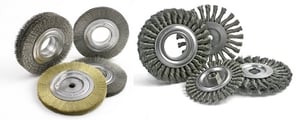 Wire wheel brushes are wheel-shaped brushing tools with sturdy hubs and metal wire filaments. They are used for cutting, cleaning, deburring, edge blending, polishing, and surface finishing. A type of power brush, wire wheels are motor-driven and may feature an arbor hole or keyway that supports their use with grinding equipment or CNC machinery. Different types of wire wheel brushes are available, but tool selection begins with an understanding of the basic wire wheel types: crimped and knotted. Manufacturers also need to consider brush tool specifications and their own application requirements.
Wire wheel brushes are wheel-shaped brushing tools with sturdy hubs and metal wire filaments. They are used for cutting, cleaning, deburring, edge blending, polishing, and surface finishing. A type of power brush, wire wheels are motor-driven and may feature an arbor hole or keyway that supports their use with grinding equipment or CNC machinery. Different types of wire wheel brushes are available, but tool selection begins with an understanding of the basic wire wheel types: crimped and knotted. Manufacturers also need to consider brush tool specifications and their own application requirements.
Crimped Wire Wheels for Uniform Brushing
Crimped wire wheel brushes feature carbon steel, stainless steel, or brass filaments that look wavy, bent, or pinched. Crimping separates these metal filaments from each other and helps to reduce the wire fatigue and wire breakage that’s caused by flexing, bending, and vibrations. Crimped wheels that are made with oil-tempered wire may cost more, but they typically last longer. During normal wheel brush use, small pieces of wire break off and leave fresh cutting edges exposed. Crimps help to create cleaner breaks. They also support consistent, uniform brushing since the tool’s cutting action is at the filament tips.
Most crimped wire wheels feature a 2” arbor hole that supports their use with shafts ranging from 1/2” to 1”. These wire wheel brushes are available in a range of sizes, but 6 and 8 inches are the most common diameters. The base material of the part or workpiece determines which filament type to select, and filament or wire size is a function of finishing requirements. Face width is also important to consider, and manufacturers can choose narrow, medium, wide, or extra wide. Narrower brush faces are ideal for corners, crevices, and irregular surfaces. Wider brush faces provide consistent brushing over larger areas.
Knotted Wire Wheels for Aggressive Brushing
Knotted wire wheel brushes feature knots or twists of metal wire, typically carbon steel or stainless steel. They support aggressive cutting and absorb bending and vibrations that can cause wire fatigue. Standard or twisted tuft brushes are twisted for about two-thirds of the filament length. The remaining third is flared slightly. With larger wire sizes and applications that require heavier brushing action, the knots may be twisted for their entire length. These knotted wire wheel brushes are known as cable twists, and are often used in oilfields and with oil pipelines.
In addition to knot or twist type, face width is an important specification to consider. Standard or twisted tuft brushes are available in medium and wide faces for uniform, heavy brushing. Stringer bead wire wheel brushes are a type of cable twist brush with a very narrow face. They’re used for surface finishing small channels and grooves, and for preparing pipes prior to welding. Like crimped wire wheel brushes with a narrow face, stringer bead brushes have longer trim for finishing irregular surfaces with corners and crevices. These knotted wire wheel brushes can also be used for cleaning cracks in asphalt and concrete.
Get the Industrial Brushes Technical Booklet
Now that you understand the basics about crimped wire and knotted wire wheel brushes, it’s time to learn how to use them under power. The Use of Industrial Brushes Guide from Brush Research Manufacturing (BRM) explains what you need to know, and includes safety guidelines. You’ll also find valuable information about other types of power brushes for surface finishing and deburring. There’s even information about BRM Flex-Hone® tools. Download The Use of Industrial Brushes Guide now.









